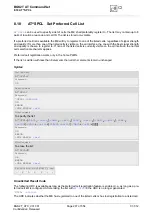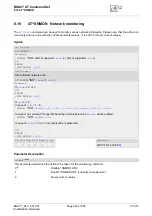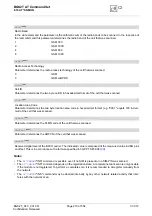
BGS2T AT Command Set
9.6 AT+CCFC
BGS2T_ATC_V01.301
Page 219 of 554
1/31/12
c
3
and activate Call forwarding (register service)
4
Erase
and deactivate call forwarding (erase service)
String type phone number of forwarding address in format specified by
. If you select
phone <number> will be registered in the network. This allows you to disable / enable CF to the same destination
without the need to enter the phone number once again. Depending on the services offered by the provider the
registration may be mandatory before CF can be used. The number remains registered in the network until you
register another number or erase it using <mode> = 4.
Type of address octet
145
Dialing string
includes international access code character '+'
129
Otherwise
Integer or sum of integers each representing a class of information, i.e. a bearer service, telecommunication ser-
vice or bearer service group as defined in 3GPP TS 22.004
1
Voice
2
Data
<class> 2 (data) comprises all those <class> values between 16 and 128, that
are supported both by the network and the MS. This means, a setting made for
<class> 2 applies to all remaining data classes (if supported). In addition, you
can assign a different setting to a specific class. For example, you can activate
Call Forwarding for all data classes, but deactivate it for a specific data class.
4
Fax
8
SMS
16
Data circuit sync
32
Data circuit async
64
Dedicated packet access
128
Dedicated PAD access
1...[7]...255
combination of some of the above classes. For example, the default setting 7
represents the sum of the integers 1, 2 and 4 (CF for voice, data and fax). The
value 255 covers all classes. If the <class> parameter is omitted, the default
value 7 is used.
5...[20]...30
Time to wait before call is forwarded, rounded to a multiple of 5 sec. (only for
=no reply)
0
Call Forwarding not active
1
Call Forwarding active
Notes
•
You can register, disable, enable and erase
4 and 5 as described above. However, querying the
status of
4 and 5 with
will result in an error ("+CME ERROR: operation not supported").
As an alternative, you may use the ATD command followed by *'# codes to check the status of these two rea-
sons. See
Star-Hash (*#) Network Commands
for a complete list of *# GSM codes. See also examples
below.
<number>
(str)
<type>
(num)
<class>
(num)
<time>
(num)
<status>
(num)
Confidential / Released
















































